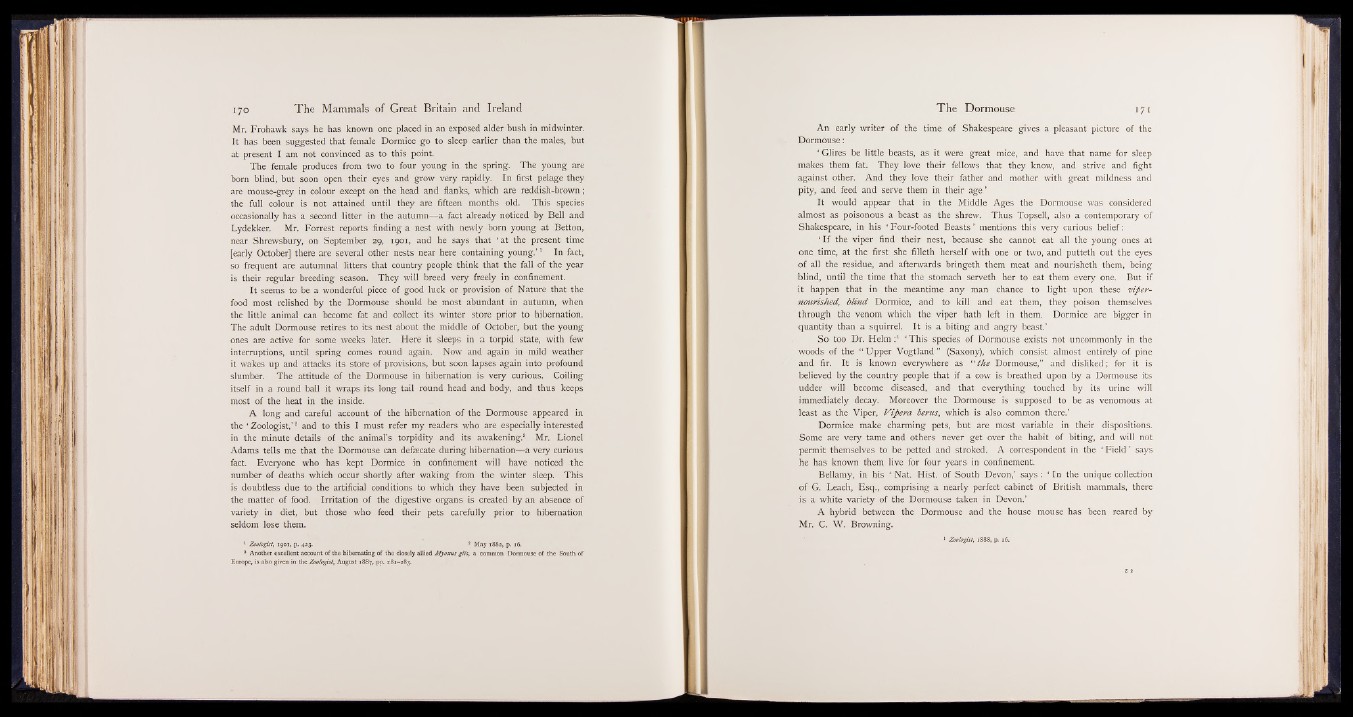
170
Mr. Frohawk says he has known one placed in an exposed alder bush in midwinter.
It has been suggested that female Dormice go to sleep earlier than the males, but
at present I am not convinced as to this point.
The female produces from two to four young in the spring. The young are
born blind, but soon open their eyes and grow very rapidly. In first pelage they
are mouse-grey in colour except on the head and flanks, which are reddish-brown;
the full colour is not attained until they are fifteen months old. This species
occasionally has a second litter in the autumn—a fact already noticed by Bell and
Lydekker. Mr. Forrest reports finding a nest with newly born young at Betton,
near Shrewsbury, on September 29, 1901, and he says that ‘ at the present time
[early October] there are several other nests near here containing young.’ 1 In fact,
so frequent are autumnal litters that country people think that the fall of the year
is their regular breeding season. They will breed very freely in confinement.
It seems to be a wonderful piece of good luck or provision of Nature that the
food most relished by the Dormouse should be most abundant in autumn, when
the little animal can become fat and collect its winter store prior to hibernation.
The adult Dormouse retires to its nest about the middle of October, but the young
ones are active for some weeks later. Here it sleeps in a torpid state, with few
interruptions, until spring comes round again. Now and again in mild weather
it wakes up and attacks its store of provisions, but soon lapses again into profound
slumber. The attitude of the Dormouse in hibernation is very curious. Coiling
itself in a round ball it wraps its long tail round head and body, and thus keeps
most of the heat in the inside.
A long and careful account of the hibernation of the Dormouse appeared in
the ‘ Zoologist,’ 2 and to this I must refer my readers who are especially interested
in the minute details of the animal’s torpidity and its awakening.8 Mr. Lionel
Adams tells me that the Dormouse can defsecate during hibernation—a very curious
fact. Everyone who has kept Dormice in confinement will have noticed the
number of deaths which occur shortly after waking from the winter sleep. This
is doubtless due to the artificial conditions to which they have been subjected in
the matter of food. Irritation of the digestive organs is created by an absence of
variety in diet, but those who feed their pets carefully prior to hibernation
seldom lose them.
1 Zoologist, 1901, p. 423. 2 May 1882, p. 16.
3 Another excellent account of the hibernating of the closely allied Myoxus glis, a common Dormouse of the South of
Europe, is also given in the Zoologist, August 1887, pp. 281-283.
An early writer of the time of Shakespeare gives a pleasant picture of the
Dormouse:
‘ Glires be little beasts, as it were great mice, and have that name for sleep
makes them fat. They love their fellows that they know, and strive and fight
against other. And they love their father and mother with great mildness and
pity, and feed and serve them in their age ’
It would appear that in the Middle Ages the Dormouse was considered
almost as poisonous a beast as the shrew. Thus Topsell, also a contemporary of
Shakespeare, in his ‘ Four-footed Beasts ’ mentions this very curious belief:
‘ I f the viper find their nest, because she cannot eat all the young ones at
one time, at the first she filleth herself with one or two, and putteth out the eyes
of all the residue, and afterwards bringeth them meat and nourisheth them, being
blind, until the time that the stomach serveth her to eat them every one. But if
it happen that in the meantime any man chance to light upon these vip er-
nourished, b lin d Dormice, and to kill and eat them, they poison themselves
through the venom which the viper hath left in them. Dormice are bigger in
quantity than a squirrel. It is a biting and angry beast.’
So too Dr. Helm:1 ‘ This species of Dormouse exists not uncommonly in the
woods of the “ Upper Vogtland ” (Saxony), which consist almost entirely of pine
and fir. It is known everywhere as “ the Dormouse,” and disliked; for it is
believed by the country people that if a cow is breathed upon by a Dormouse its
udder will become diseased, and that everything touched by its urine will
immediately decay. Moreover the Dormouse is supposed to be as venomous at
least as the Viper, Vipera berus, which is also common there.’
Dormice make charming pets, but are most variable in their dispositions.
Some are very tame and others never get over the habit of biting, and will not
permit themselves to be petted and stroked. A correspondent in the ‘ Field ’ says
he has known them live for four years in confinement.
Bellamy, in his ‘ Nat. Hist, of South Devon,’ says : ‘ In the unique collection
of G. Leach, Esq., comprising a nearly perfect cabinet of British mammals, there
is a white variety of the Dormouse taken in Devon.’
A hybrid between the Dormouse and the house mouse has been reared by
Mr. C. W. Browning.
1 Zoologist, 1888, p. 16.